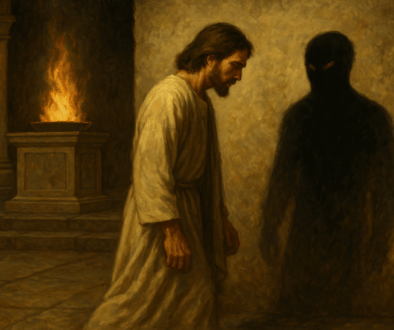Shadow Work and the Whitewashed Tomb
Why Are We So Afraid of the Tomb?
We’ve all worn the good Christian face.
The Sunday smile. The quiet-time quote. No room for the mess.
And yet, strangely, it’s not the wild sinners Jesus lashes out at.
It’s the polished ones.
The clean. The correct.
The ones who’ve done everything… except enter the tomb.
Whitewashing Tombs in Jerusalem
Before Passover, tombs around Jerusalem were whitewashed with lime.
Not for vanity — but protection.
A mercy, really. So no one would accidentally brush against death and become unclean.
It wasn’t pride. It was practical.
A way to keep things clean.
A way to keep things safe.
But then Jesus shows up and flips the meaning:
“You are like whitewashed tombs…”
Wait—what?
If the whitewash was meant to help, why does He make it sound like a curse?
What is He seeing… that we’ve trained ourselves not to?
A Psychological and Spiritual Diagnosis
We don’t whitewash out of malice.
We do it to survive.
From childhood, we learn which parts of us are “too much.”
Too loud. Too needy. Too angry. Too soft.
So we bury them.
Not to deceive.
To stay loved.
To stay clean.
Whitewashing is a mercy—at first.
Just like the tombs outside Jerusalem.
A way to keep others safe from our pain.
A way to protect ourselves from being seen.
But pain that’s buried isn’t healed.
And shame becomes the cement.
“You are like whitewashed tombs… outwardly you appear righteous, but within you are full of hypocrisy and lawlessness.”
— Matthew 23:27–28
This isn’t just a critique of religious hypocrisy.
It’s a spiritual diagnosis. A psychological one, too.
Jesus sees through the persona — not to shame, but to reveal.
He’s not calling us evil.
He’s calling us fragmented.
The persona is what we present:
Polite. Spiritual. Productive. Competent.
The shadow is what we’ve buried:
Grief. Envy. Addiction. Rage. The desperate need to be loved.
We polish the exterior while the inside groans.
But here’s the cost of suppression:
What we don’t face, we project.
What we bury, we become haunted by.
And eventually… it leaks.
It leaks through judgmentalism.
Through passive aggression.
Through “doing everything right” and still feeling like a fraud.
Through quiet sabotage, chronic burnout, or collapse.
Religious hypocrisy isn’t just moral failure.
It’s the psychic pressure of an unlived inner life.
A tomb cracking at the seams.
Modern psychology has names for this:
Shadow — Jung’s term for the disowned self.
Exiles and Protectors — in Internal Family Systems, the buried parts and the masks that guard them.
Incongruence — Carl Rogers’ term for the painful split between our felt truth and our false self-image.
Cognitive distortions — what Albert Ellis found when tracing our suffering to unexamined beliefs.
Different language. Same descent.
“The brighter the light, the darker the shadow.”
— Robert Bly
The whiter the tomb, the darker it is inside.
The more polished the persona, the more neglected the soul.
We don’t mean to bury ourselves — but we do.
Sometimes out of fear.
Sometimes out of shame.
Sometimes out of love — to protect others.
To stay clean. To appear righteous.
But a tomb is still a tomb, no matter how white it’s been washed.
And eventually, what we bury starts to haunt us.
The truth is:
We all have tombs inside us.
Buried emotions. Disowned selves.
Memories paved over with “I’m fine.”
We all want to be good.
But in trying so hard to be good,
we’ve forgotten how to be whole.
Jesus Names the Tomb Before He Enters It
This moment isn’t random.
Jesus names the tombs just days before He walks into His own.
“To honor and accept one’s own shadow is a profound spiritual discipline. It is whole-making, and thus holy — the most important experience of a lifetime.”
— Robert A. Johnson
This isn’t just a rebuke.
It’s a roadmap.
As prophet, He exposes the shadow of spiritual pride.
As pattern, He does what we’re all afraid to do:
He descends.
He doesn’t just defeat death.
He shows us how to let our false selves die.
And look at the timing:
The tomb critique comes right before His burial.
As if to say:
“You’ve spent your lives sealing your pain behind lime and stone.
Watch what happens when I walk into a tomb — and come out whole.”
This is the paradox of the Christian path:
The way up… is down.
The path to resurrection runs straight through the grave.
Shadow Work as Christian Practice
Jesus doesn’t shame us for having a shadow.
He shows us how to walk into it.
To follow Christ is not to avoid the tomb —
but to enter it with Him.
This is the work of spiritual maturity.
Not more performance.
Not more certainty.
But the courage to descend.
To face what we’ve hidden.
To meet the parts we exiled to survive.
Shadow work isn’t indulgence.
It’s soul surgery.
“For most of us, enlightenment isn’t a sudden awakening,
but a slow process of shining the light of consciousness
onto those rejected, forgotten, and denied places within.”
— Toko-pa Turner
There are many ways in:
- IFS (naming the inner cast)
- Somatic work (listening to the body’s story)
- Reparenting (nurturing the child who had to shut down)
- Compassionate inquiry (tracing behavior back to the break)
- Jungian analysis (meeting the shadow to find its gold)
Different names. Same descent.
The movements:
🪞 Notice the mask.
🪦 Name the buried part.
😭 Grieve.
🧶 Integrate.
This is what repentance looks like from the inside.
Death-Place or Birth-Place?
A tomb is where the world says, “It’s over.”
But in God’s hands, the tomb becomes a doorway.
Jesus could’ve rebuked the Pharisees and walked away.
Instead, He entered a tomb — and undid the meaning of death from the inside.
The tomb is the place where whitewash cracks.
Where the false self lays down.
Where the dead things speak.
“You can’t whitewash pain. You can only resurrect it.”
Let the Tomb Open
In the Christian story, light shines brightest from inside a tomb.
Jesus doesn’t just call us to see our shadow —
He walks us through it.
Yes, He names the hypocrisy.
But only because He’s already waiting… three days deeper in.
We walk in — not to die forever,
but to rise as someone real.
“The goal of life is not perfection, but wholeness.”
— Robert A. Johnson
The church — and the world — do not need more polished personas.
They need resurrected people.
People who have sat with their sealed places,
and found Christ already there.
So let the tomb open.
Let the grief rise.
Let the dead things speak.
And let your life become a witness —
that the way through shame
is not avoidance.
It’s resurrection.



